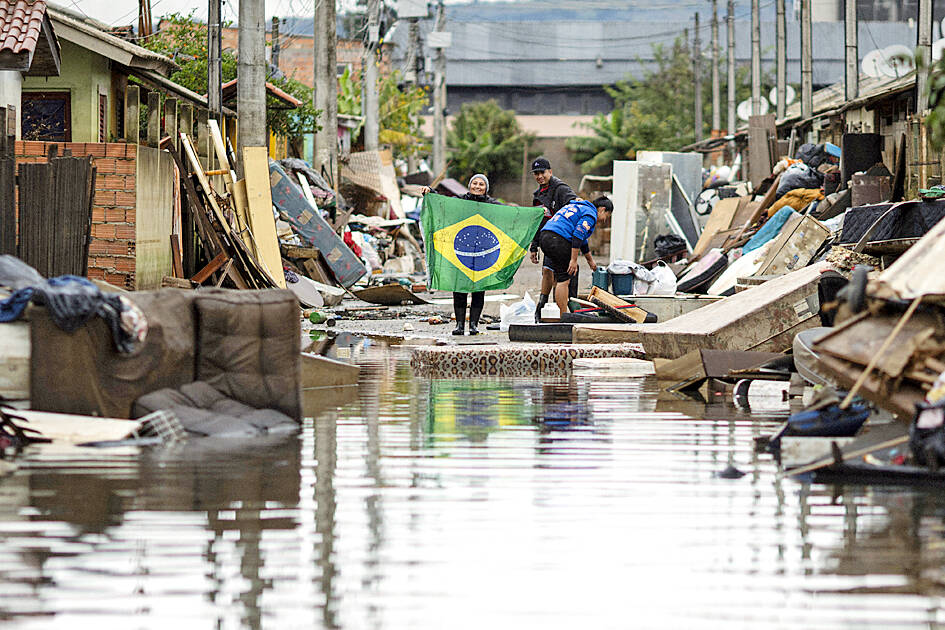Climate change doubled the likelihood of the historic floods in southern Brazil and amplified intense rains caused by the El Nino weather phenomenon, scientists said on Monday.
Three months’ worth of rain was dumped on the southern state of Rio Grande do Sul over two weeks in an “extremely rare event, expected to occur only once every 100 to 250 years,” according to a study published by the World Weather Attribution (WWA) group.
The flooding in late April and early last month submerged cities, farms and an international airport, affecting more than 90 percent of the vast state, an area equivalent to that of the UK.

Photo: EPA-EFE
The disaster left 172 people dead and displaced about 600,000.
“The researchers estimated that climate change made the event more than twice as likely and around six to nine percent more intense,” the WWA said in a statement.
On top of that, the El Nino phenomenon made rainfall between three and 10 percent more intense, said the global network of scientists that assesses the link between extreme weather events and climate change.
“The scary thing about these floods is that they show us that the world needs to be prepared for events so extreme, they are unlike anything we’ve seen before,” said Maja Vahlberg, climate risk consultant at the Red Cross Red Crescent Climate Centre.
Regina Rodrigues, a researcher at the Federal University of Santa Catarina, said the disaster showed that even when El Nino was in a weakening phase, as it currently is, it could be extremely dangerous.
“Climate change is amplifying the impact of El Nino in southern Brazil by making an extremely rare event more frequent and intense,” she said.
Of the four biggest floods ever seen in the regional capital Porto Alegre, “three occurred in the last nine months,” Rodrigues told a news conference. “This is very rare.”
Rio Grande do Sul is particularly vulnerable to flooding, with a vein-like network of river systems covering the region.
However, until last year the city had not seen a major flood in six decades.
This might have lulled residents into a false sense of security, Vahlberg said.
A flood protection system in Porto Alegre, built after deluges in 1941 and 1967, was designed to withstand water levels up to 6m, but Vahlberg said a lack of maintenance saw it start to fail at 4.5m.
Criticized by residents as ugly and blocking their view of a lake, the system faced a push to have it dismantled entirely.
Warnings had been issued a week before the flooding, but these might not have reached everyone and “the public may not have understood the severity of the expected impact,” Vahlberg said.
The scientists said deforestation, to make way for agriculture, and the rapid urbanization of cities like Porto Alegre also “worsened the impacts.”

Seven people sustained mostly minor injuries in an airplane fire in South Korea, authorities said yesterday, with local media suggesting the blaze might have been caused by a portable battery stored in the overhead bin. The Air Busan plane, an Airbus A321, was set to fly to Hong Kong from Gimhae International Airport in southeastern Busan, but caught fire in the rear section on Tuesday night, the South Korean Ministry of Land, Infrastructure and Transport said. A total of 169 passengers and seven flight attendants and staff were evacuated down inflatable slides, it said. Authorities initially reported three injuries, but revised the number

A colossal explosion in the sky, unleashing energy hundreds of times greater than the Hiroshima bomb. A blinding flash nearly as bright as the sun. Shockwaves powerful enough to flatten everything for miles. It might sound apocalyptic, but a newly detected asteroid nearly the size of a football field now has a greater than 1 percent chance of colliding with Earth in about eight years. Such an impact has the potential for city-level devastation, depending on where it strikes. Scientists are not panicking yet, but they are watching closely. “At this point, it’s: ‘Let’s pay a lot of attention, let’s

UNDAUNTED: Panama would not renew an agreement to participate in Beijing’s Belt and Road project, its president said, proposing technical-level talks with the US US Secretary of State Marco Rubio on Sunday threatened action against Panama without immediate changes to reduce Chinese influence on the canal, but the country’s leader insisted he was not afraid of a US invasion and offered talks. On his first trip overseas as the top US diplomat, Rubio took a guided tour of the canal, accompanied by its Panamanian administrator as a South Korean-affiliated oil tanker and Marshall Islands-flagged cargo ship passed through the vital link between the Atlantic and Pacific oceans. However, Rubio was said to have had a firmer message in private, telling Panama that US President Donald Trump

CHEER ON: Students were greeted by citizens who honked their car horns or offered them food and drinks, while taxi drivers said they would give marchers a lift home Hundreds of students protesting graft they blame for 15 deaths in a building collapse on Friday marched through Serbia to the northern city of Novi Sad, where they plan to block three Danube River bridges this weekend. They received a hero’s welcome from fellow students and thousands of local residents in Novi Said after arriving on foot in their two-day, 80km journey from Belgrade. A small red carpet was placed on one of the bridges across the Danube that the students crossed as they entered the city. The bridge blockade planned for yesterday is to mark three months since a huge concrete construction